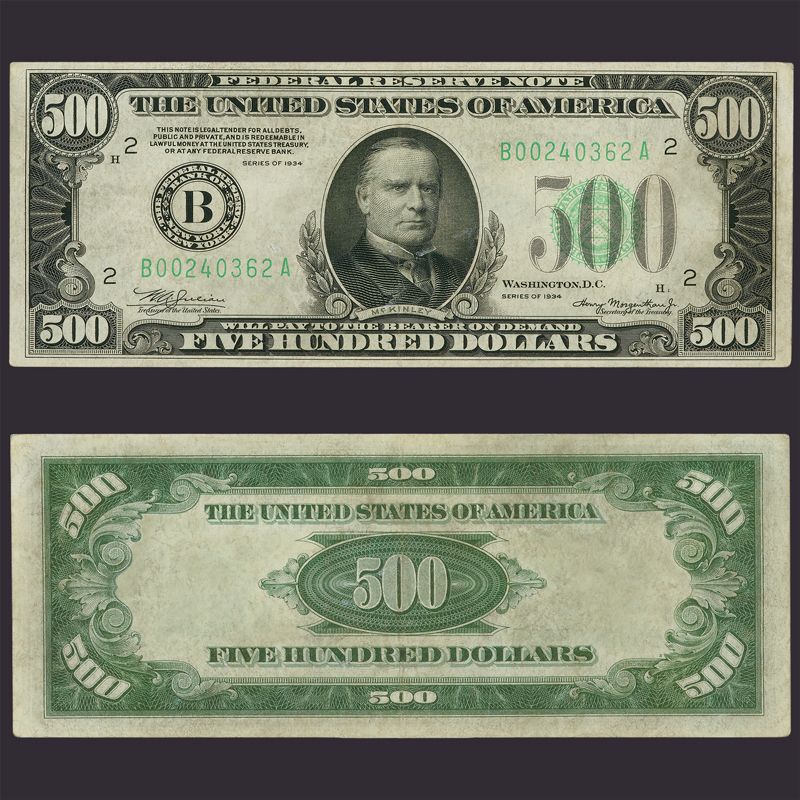In an increasingly cashless society, all physical currency has become comparatively rare: It’s never been easier for most people to simply use their debit card, Venmo, or saved payment information to complete most of their purchases. Even so, approximately $1.87 trillion in physical U.S. currency is still in circulation — the vast majority of which naturally consists of the six most common notes ($1, $5, $10, $20, $50, $100). They weren’t always the most common, however, as America has produced many now-rare forms of currency throughout its financial history. Here are six of them.
 Half-Cent Coin
Half-Cent Coin
The next time you’re charged a fraction of a penny for something and bemoan the fact that you don’t have exact change, feel free to curse fate — and the U.S. Mint — for discontinuing the half-cent coin way back in 1857. Making the humble penny look like big money in comparison, it was introduced as a result of the Coinage Act of 1792 and had five different designs during its run. All of them were variations of Liberty herself, and the coin was made of 100% copper. A fraction of a cent is referred to as a mill (₥), a now-abstract unit of currency that lives on in accounting (and occasionally gas prices); milles were usually used for small purchases such as sales tax before losing most of their real-world value.
 $2 Bill
$2 Bill
Every kiddo’s favorite banknote featured Thomas Jefferson on the front (or obverse, as it’s called) and John Trumbull’s painting “Declaration of Independence” on the back (reverse), with the U.S. Currency Education Program estimating that there are still 1.2 billion in circulation.
A lesser-known fact is that the note is actually still issued by the Federal Reserve Board, which orders new currency from the Treasury’s Bureau of Engraving and Printing (BEP) every year. Unlike the bills you’re more familiar with, however, the $2 bill is only ordered every two to four years. There’s a good reason for that: most of these orders are to replace notes that have received too much wear and tear to remain in everyday use; because $2s aren’t used as often, they don’t need to be replaced as often. In some ways, this is actually a self-fulfilling prophecy: because people think the bills are uncommon, they treat them that way, inadvertently ensuring that they maintain this rarefied status.
 $500 Bill
$500 Bill
Though it hasn’t been in circulation since 1969, the $500 bill is unique among discontinued currencies in that it’s still considered legal tender. First introduced on a federal level in 1862, the high-denomination bill featured everyone from John Quincy Adams and William Tecumseh Sherman to Abraham Lincoln and William McKinley throughout its tenure. Now a sought-after collector’s item, it’s worth much more than $500 if you can get your hands on one.
 Three-Cent Coin
Three-Cent Coin
The problem with three-cent stamps is that there’s no way to buy them without receiving change back. Prepare to be amazed, dear reader, as such a coin used to exist from 1851-1889: the noble three-cent piece, whose convenience was unmatched in antebellum America. They were made of silver, which helped lead to their downfall — that precious metal was frequently hoarded during the Civil War, meaning that the three-cent coin wasn’t as widely circulated as it was intended to be. Then, when the price of stamps was eventually increased, our intrepid hero’s utility was drastically reduced and it stopped being produced.
 $5,000 Bill
$5,000 Bill
There’s rare, and then there’s the $5,000 bill. Originally created to help fund the Revolutionary War, this fine specimen didn’t come into official government use until 1868, when another history-altering war was raging. It was blessed with a portrait of our fourth president (or James Madison, as his friends called him) and recalled by the 37th, one Richard Nixon, in an effort to prevent money launderers from carrying out their ill deeds with its assistance. Only a few hundred remain, making them as valuable as they are rare.
Media Release/Interesting Facts


 Half-Cent Coin
Half-Cent Coin:max_bytes(150000):strip_icc()/US0200-Two-Dollar-Bill-series-2003-A-d124f796303247cb8771087fbb98065c.jpg) $2 Bill
$2 Bill $500 Bill
$500 Bill